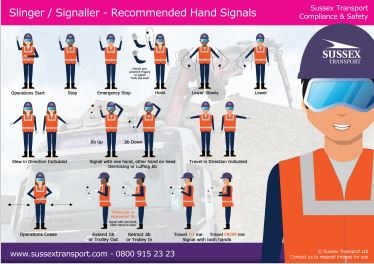A Slinger Signaller is one of the most critical roles on a construction site (also now used on any industrial site where a crane is involved).
Not only do they have to have excellent organisational skills, but observation and concentration skills are also paramount to ensure crane operators and other site personnel are kept safe.
Sussex Transport offers a fantastic range of training courses with industry-recognised certifications, including qualifications for Slinger Signallers.
If you want to find out more about these – and the job role itself – read on.
What Is A Slinger Signaller?
So, what is a Slinger Signaller?
A Slinger Signaller helps the person operating the crane by being their eyes and ears on the ground. If a crane operator’s view is obstructed, this can lead to loading and lifting risks which could compromise general site safety.
A Slinger Signaller primarily communicates with the Crane Operator using a series of hand signals. These hand signals need to be precise, easy to make and easy to understand.
The standard hand signals used by Slinger Signallers in the UK can be found in
BS7121, the code of practice for the safe use of cranes.
Of course, there may be times when alternative methods of communication are required.
For example, adverse weather conditions could restrict visibility. As could any work involving tower cranes. In these circumstances, batons can be used as an alternative. Two-way radios are also a common substitute.
There are times when the operator (of say a truck-mounted crane) is also the Slinger Signaller, so our hiab drivers are all also trained Slinger Signallers for that reason.
Slinger Signaller Training With Sussex Transport
Because of the responsibilities held by Slinger Signallers, specialist training is highly recommended for anyone thinking about taking on the role.
Our course can offer trainees either ALLMI, NPORS or Sussex Transport | Training Division certification.
Depending on experience, our Slinger Signaller training can last between 1 – 3 days and include the following topics:
• Safety Awareness Session.
• Health & Safety Work Act 1974, sections 2,7,8 & 9.
• Current PUWER Regulations.
• The current Lifting Operations and Lifting Equipment Regulations.
• Safe Working Loads, Working Load limits and Safety certificates.
• Inspection Lifting Tackle.
• Safe operating practices.
• Methods of Slinging.
• Weight Estimation.
• Pre Lifting Checks.
• Lifting Accessories Checks.
• Lifting and Moving.
• Post Lifting Checks.
• Practical Exercise and Assessment
Are you interested in a career as a Slinger Signaller or looking for training or a refresher
Find out more about our Slinger Signaller training.
